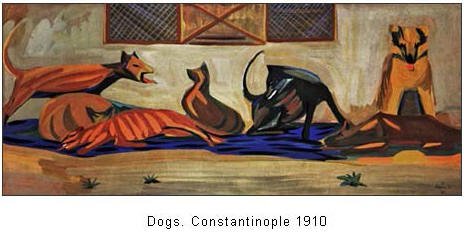Martiros Saryan is one of the greatest Armenian painters of 20th century
Martiros Saryan – was born on February 29, 1880 in Nor Nakhijevan (During several centuries it was cultural center of Armenians of Don. Today Nor Nakhijevan is a part of Rostov Na Danu).
In 1895 he completed the Nor Nakhichevan’s school. During his school years Saryan’s progress in drawing was appreciated by special certificate.
From 1897 to 1904 Martiros Saryan studied at the Moscow School of Arts.He exhibited his works in various shows.
He first visited Russian Armenia in 1901.
From 1910 to 1913 Martiros Saryan traveled extensively in Turkey, Egypt and Iran (Persia). In the spring of 1914, Saryan left for Tiflis, Georgia. He participated in the activities of the Armenian ethnographic community and visited Gokhtn (Southern Armenia, presently in Azerbaijan).
In 1915 he went to Echmiadzin to help refugees who had fled from the Armenian genocide in the Ottoman Empire. In 1916 he traveled to Tiflis where he met Lusik Agayan. They got engaged in the Tskhneti village church on April 17 of 1917.




Martiros Saryan
In 1918 -1919, Saryan lived with his family in Nor Nakhichevan. He initiated the establishment of an Armenian Local Lore museum. At the Lotus exhibition, where Armenian and Russian painters were exhibited, Saryan displayed 45 paintings. Aside from his earlier paintings, his latest paintings were also exhibited and revealed the oriental theme in a new way: ‘Portrait of N. Komurjyan’, ‘Old Tiflis’, and ‘Red Horse’.
The artist also designed G.Chalkhushyan’s Red Book, dedicated to Armenian Genocide, and M. Shahinyan’s collection of poems Orientalia. In 1918, their son, Sarkis, was born. Saryan’s second son, Ghazaros (Lazar), was born in 1920.
In 1921 Saryan moved to Soviet Armenia. While most of his work reflected the Armenian landscape, he also designed the National Emblem and the flag of the Soviet Armenia. In the other remarkable work of this period, the sketch of the curtain of First Drama Theater in Yerevan, the artist depicted a synthesized image of his reborn homeland
From 1926 – 1928 he lived and worked in Paris. But the main part of his works from that period were destroyed in a fire on board the boat on which he returned to the Soviet Union.
From 1928 -1929, Saryan displayed his paintings in various exhibitions in Yerevan and Moscow.
In 1930, the Almast opera by A.Spendiarov, designed by Saryan, premiered in the Odessa Opera House. In 1932, Saryan designed the second act of the Golden Cockerel opera by N.Rimski-Korsakov staged in the Moscow Stanislavski Theater. In 1934, Saryan traveled to Turkmenistan and created a series of paintings in which one could obviously see the artist’s previous attraction to oriental motives. At the same year Persian poet Firdausi’s Rustam and Zohrab poem illustrated by Saryan and edited by the famous Armenian poet E.Charents was published.
In 1937 the period of harsh repressions began. Saryan’s 12 portraits of the brightest literature and public figures subjected to repressions were burnt. Only one of them survived. The museum workers managed to hide the Charents’ portrait (1923).
The years of the WWII (1941-1945) seemed to have given some freedom for creativity. Saryan created a series of wonderful portraits of cultural figures.
In 1947, the Academy of artists of USSR was established, and Saryan became its member. But at the same time he was accused of formalism – the most terrible verdict for the artist of that time (1948). The Soviet Art journal stated that Saryan’s art was ‘the armenianized version of the French bourgeois formalism’ and could not be considered national’.
When N.S.Khrushchev came to power, the situation in art has changed. Saryan was able to breathe freely. His interest in landscapes creating at the open air that had been outlined in his creative method since 1952 acquired further development. The artist traveled throughout Armenia once again creating a series of landscapes in Dvin (1952), in Sevan (1953) and in Byrakan (1957-1958). Yet again, Mount Ararat rises in the artist’s paintings – two-peaked biblical mountain in the shine of sun beams. The painter sustained the ability to observe, amaze, admire, and rejoice in every unique instant of life. The works of this period were included in the series ‘My Motherland’, for which Saryan was awarded the Lenin prize in 1961.
In 1966, Saryan received the State Prize of the Armenian SSR
In 1971-1972 Saryan created a series of felt-tip drawings in which the artist’s return to the harmonious melodies of his early series ‘Fairy Tales and Dreams’ is evident. Still, these drawings are different due to some meditative immersion in the images of Armenian nature, which were in the heart and memory of the artist. The final drawing is dated by the Master 04 – 04 -72, which was a month prior to his death.







